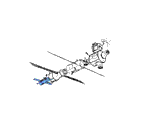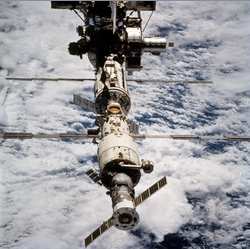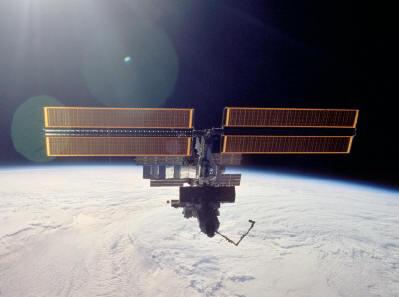Report #9, 4 p.m. CST, Friday, Feb. 28, 2003, Mission Control
Ctr
 Approaching their 100th day in orbit, the
International Space Station’s Expedition 6 crewmembers
completed an important test of on-orbit spacewalk preparation this
week, while program managers cleared the way for a crew rotation
scenario that will bring the three-man crew back to Earth in
Kazakhstan in May.
Approaching their 100th day in orbit, the
International Space Station’s Expedition 6 crewmembers
completed an important test of on-orbit spacewalk preparation this
week, while program managers cleared the way for a crew rotation
scenario that will bring the three-man crew back to Earth in
Kazakhstan in May.
Monday Commander Ken Bowersox and Flight Engineer Don Pettit
conducted a successful test of the ability of two crewmembers to
safely get into American spacesuits without the assistance of a
third crewmember; that ability is a prerequisite to sending smaller
crews to ISS while the space shuttle fleet remains grounded during
the investigation of the Columbia accident. As Flight Engineer
Nikolai Budarin videotaped the activity and offered his advice,
Bowersox and Pettit helped each other into their Extravehicular
Mobility Units, donned jet backpacks called SAFERs, set up the
necessary equipment for a pre-breathe of oxygen to purge nitrogen
from their bloodstreams, and then got out of the spacesuits.
 Through a series of meetings, ISS partners
announced that near-term station crew rotations will involve
two-person crews flying to the International Space Station in
Russian Soyuz spacecraft, beginning with the previously scheduled
launch in late April or early May. Expedition 6 will return to
Kazakhstan in early May in the Soyuz currently docked to the
station. Smaller crews will mean a reduced demand for on-board
supplies, which can be delivered only on Russian Progress ships
until the shuttles are cleared for flight. One Progress arrived at
the station early this month, and the next is due to launch in
June.
Through a series of meetings, ISS partners
announced that near-term station crew rotations will involve
two-person crews flying to the International Space Station in
Russian Soyuz spacecraft, beginning with the previously scheduled
launch in late April or early May. Expedition 6 will return to
Kazakhstan in early May in the Soyuz currently docked to the
station. Smaller crews will mean a reduced demand for on-board
supplies, which can be delivered only on Russian Progress ships
until the shuttles are cleared for flight. One Progress arrived at
the station early this month, and the next is due to launch in
June.
U.S. astronauts Mike Foale and Ed Lu, and Russian cosmonauts
Yuri Malenchenko and Alexander Kaleri, all of whom were previously
named to various ISS expedition crews and who have many months of
preparation for ISS missions under their belts, are training at the
Gagarin Cosmonaut Training Center in Star City, Russia.
Specialists at the Payload Operations Control Center, at
NASA’s Marshall Space Flight Center in Huntsville, Ala.,
continue troubleshooting the Microgravity Sciences Glovebox in the
station’s Destiny laboratory module. The MSG, developed by
the European Space Agency with scientists at MSFC, provides an
enclosed space for experiments involving fluids or flames. This
week Pettit did troubleshooting for the ground-based team looking
for the cause of the failure of two power controller boxes on the
facility last November, and this month’s tripping of a
circuit breaker on the facility shortly after the installation of
new power boxes delivered on the recent Progress resupply ship.
Additional hands-on tests are being planned for next week.

Tuesday morning the crewmembers answered questions about their
mission and human spaceflight from middle school science students
from Pettit’s old junior high school, Mark Twain Middle
School in Silverton, Ore. During the event -- staged at the Oregon
Museum of Science and Industry in Portland, Ore. -- Pettit spoke
with the teacher, who was his own science teacher in junior high
school. On Friday the crewmembers conducted interviews with USA
Today and KPTV-TV in Portland, Ore.
 ANN's Daily Aero-Linx (04.30.25)
ANN's Daily Aero-Linx (04.30.25) ANN FAQ: Turn On Post Notifications
ANN FAQ: Turn On Post Notifications Classic Aero-TV: Agile Aeros Jeff Greason--Disruptive Aerospace Innovations
Classic Aero-TV: Agile Aeros Jeff Greason--Disruptive Aerospace Innovations Aero-News: Quote of the Day (04.30.25)
Aero-News: Quote of the Day (04.30.25) ANN's Daily Aero-Term (04.30.25): Expedite
ANN's Daily Aero-Term (04.30.25): Expedite





